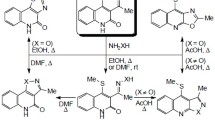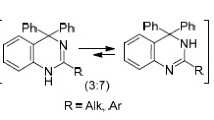Abstract
Condensation of 3,5-dinitro-4-chloro-6-methoxy-2-methylquinoline (1) with benzylamine, ethanolamine and/or thioglycolic acid afforded the quinoline derivatives4 a-c. Cyclization of4 a and4 b with alkali and condensation of1 with glycine in sodium carbonate solution furnish 2H-imidazo[4,5-c]quinoline derivatives5 a-c, respectively. Treatment of5 b with benzaldehyde in presence of zinc chloride gave the styryl derivative6. 1 reacted with sodium azide to give the azido derivative4 d, which upon treatment with phenylhydrazine or sodium borohydride yielded the 4-amino derivative4 3. Moreover,1 was treated with phenylhydrazine to give4 f, which cyclized in 10% sodium hydroxide solution to the corresponding v-triazolo[4,5-c]quinoline 3-oxide derivative7. When however4 f was treated with dilute hydrochloric acid, the corresponding phenylpyrazolo[3,4,5-de]quinoline derivative8 was obtained.
Zusammenfassung
Kondensation von 3,5-Dinitro-4-chlor-6-methoxy-2-methylchinolin (1) mit Benzylamin, Ethanolamin und/oder Thioglycolsäure ergab die Chinolinderivate4 a-c. Cyclisierung von4 a und4 b mit Alkali und Kondensation von1 mit Glycin in Natriumcarbonatlösung lieferte 2H-imidazo[4,5-c]chinolin-Derivate5 a-c. Behandlung von5 b mit Benzaldehyd in Gegenwart von Zinkchlorid ergab das Styrylderivat6. 1 wurde mit Natriumazid zum Azidoderivat4 d umgesetzt, das mit Phenylhydrazin oder Natriumborhydrid zum 4-Aminoderivat4 e weiterreagierte.1 ergab mit Phenylhydrazin4 f, das in 10% NaOH-Lösung zum entsprechenden Triazolo[4,5-c]chinolin-Derivat7 cyclisierte. Aus4 f wurde mit verdünnter Salzsäure das Phenylpyrazolo[3,4,5-de]chinolin8 erhalten.
Similar content being viewed by others
References
S. Patai, The chemistry of functional groups: The chemistry of Nitro and Nitroso groups, part II. New York: J. Wiley, 1970.
G. W. Stacy, B. V. Ettling, andA. J. Papa, J. Org. Chem.29, 1537 (1964).
G. W. Stacy, B. V. Ettling andA. J. Papa, J. Med. Chem.10, 211 (1967).
G. Jaeger, Zeitschrift für Krystallographie und Mineralogie42, 363 (1887).
D. W. Russell, Chem. Commun.1965, 498.
R. Andrisano andD. D. Casoni, Bull. Sci. Fac. Chim. Ind. BolognaI, 7 (1943); Chem. Abstr.41, 723 (1947).
D. S. Deorha, V. K. Mahesh andS. K. Mukerji, J. Indian Chem. Soc.40, 901 (1963).
O. L. Brady andC. Waller, J. Chem. Soc.1930, 1218.
K. C. Roberts andH. B. Clark, J. Chem. Soc.1935, 1312.
C. K. Banks, J. Amer. Chem. Soc.66, 1127 (1944).
A. R. Surrey andR. A. Cutler J. Amer. Chem. Soc.73, 2623 (1951).
C. S. Rendestvedt andP. K. Chang, J. Amer. Chem. Soc.77, 6532 (1955).
Author information
Authors and Affiliations
Rights and permissions
About this article
Cite this article
Abbasi, M.M., Nasr, M. & Zoorob, H.H. Base induced cyclization of some quinolines. Formation of fused nitrogen heterocyclic ring system. Monatshefte für Chemie 111, 963–969 (1980). https://doi.org/10.1007/BF00899263
Received:
Accepted:
Issue Date:
DOI: https://doi.org/10.1007/BF00899263




